Medical Care
Medical care on the frontier was primitive. There were doctors and midwives who offered care, but most people used home remedies and passed-on cures. Most were herbal in nature, but some relied on magical cures.
Death came frequently to frontier homes, and often struck children. Census records in Kentucky about this time showed that a typical family had three to seven children, but only about half of them ever reached their fifth birthday.
Death rates were also high for young women of childbearing age. People didn’t understand about germs, so many mothers died giving birth from infections caused by unclean hands or instruments used by doctors or midwives.
Frances Woodfin of Nashville died on January 29, 1832, at the age of 24. Since she had just given birth to a daughter, Cordelia Ann, in December, Frances' death was probably related to childbirth. Tragically Cordelia died eight months later during a cholera outbreak and is buried beside her mother in Nashville’s City Cemetery.
Diseases like diphtheria, cholera, and influenza would rage through communities, sometimes killing several people in the same household. Richard and Mary Moore buried eight of their 11 children from diphtheria.
Disease also affected slaves. A Bible, published in 1816, and used in a Tennessee family, has a page with the handwritten title “Negro Family Record” at the top and a list of names with the year of birth and year of death below. Out of 26 names, four died of cholera.
Ancient Theory of Humours
In the 1700s, doctors and caregivers still practiced the ancient theory of humours. They believed that good health was achieved by the proper balance of the body’s fluids, or humours. These fluids were blood, phlegm, yellow bile, and black bile.
An excess of one of these fluids, or so they believed, would cause illness. If this happened, the excess fluid needed to be removed. This was done by bleeding the patient through small cuts, by inducing vomiting through purges, causing diarrhea by giving enemas, or causing blisters by applying irritants to the skin.
Most of the time these treatments didn’t work. Bleeding a person who was sick could cause them to go into shock and die. Sometimes the treatment would work. Midwife Martha Ballard always recorded her treatments. In 1790 she wrote, “I gave Nancy a dose of salt and water which caused her to puke. She threw up two worms and seemed easier.”
Other frontier cures:
Baldness:
|
Rub with onions until it is red then rub afterwards with honey |
| Consumption: |
Every morning cut up a little fresh earth, and lying down, breathe into the hole for quarter of an hour. |
| Earache: |
Put black wool, wet with brandy and pepper in ear |
Shingles:
|
Bleed a cat and apply blood directly |
Fever:
|
Before going to bed, let the patient take off his clothes and stand under a sieve suspended by a line. Let a person pour into the sieve a pail filled with water just drawn from a well. The shock will be considerable. |
Knoxville Gazette
Nov. 1, 1794
Picture Credits:
- An illustration depicting the death of Sarah Hawkins Sevier in early 1780 shortly after giving birth to her tenth child. Sarah was the first wife of John Sevier, first governor of Tennessee. Reprinted from The Overmountain Men by Pat Alderman and illustrator Bernie Andrews.
- Drawing entitled, “The Wounded Pioneer.” This drawing was published in 1859 by John Frost in the book, Heroes and Hunters of the West. It shows a group of men carrying a wounded companion. New York Public Library
- Drawing entitled, “Leaving the Weak to die.” This drawing was published by Kilburn & Cross in 1890 in the book, Marvels of the new west. It shows a man in 1846 lying beside a fire as a small group continues to travel in the distance. New York Public Library
-
Drawing entitled, “The Suffering Family.” This drawing was published in 1856 by John Chapin in the book, The historical picture gallery: or, scenes and incidents in American history.” It shows a frail looking woman and infant in 1810 being approached by a frontiersman. New York Public Library
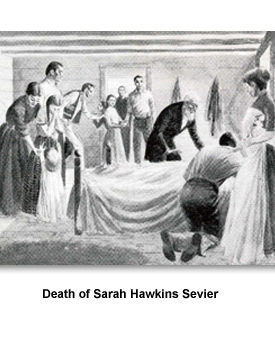
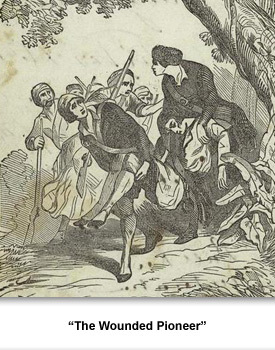
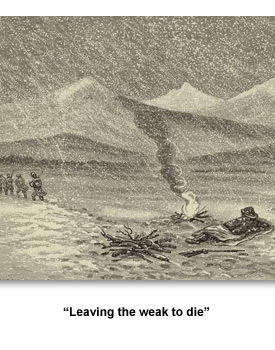
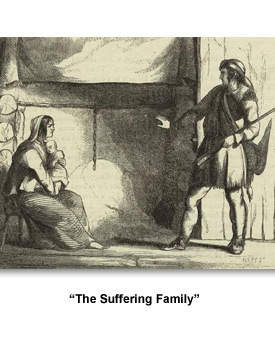
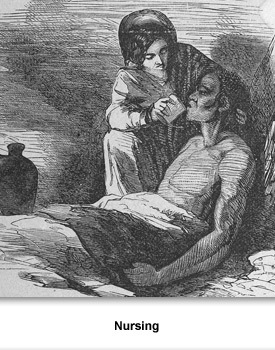
 Sponsored by: National Endowment for the Humanities
Sponsored by: National Endowment for the Humanities